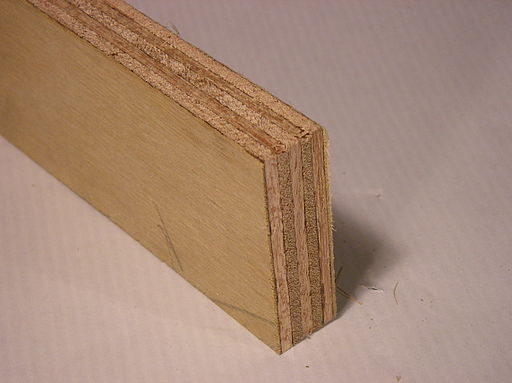Although humans have used composite materials for millennia, the concept of composites as a distinct classification of materials was not recognized until the mid-20th century. Composite materials are formed from two or more distinct phases of materials. This is in contrast with metal alloys, which we studied in an earlier lesson. In metal alloys, additional atoms, compounds, or phases are dissolved into the base metal. This solid mixing does not result in distinct phases, which are present in composite materials. Possibly the earliest usage of a composite was by the ancient Mesopotamians (circa 3400 BCE) who realized that gluing wood at angles produced better properties than single-ply wood. Modern five-ply plywood has five plies arranged in steps of 45° (0, 45, 90, 135, and 180 degrees) for better strength. A photo of an unknown type of plywood is shown below.

Around 1500 BCE in the Fertile Crescent, humans began adding straw to strengthen clay bricks. Human structures were no longer limited to wood or the piling of stone. Unreinforced clay bricks, like most ceramics, are strong under compression stress, but unstable when subject to tensile stresses. So, unreinforced clay bricks carry the load but will readily fall apart. Except for its unstable nature under tensile stresses, clay is otherwise an ideal building material. As a raw material, it is available almost everywhere and, before drying, it can be easily worked into the desired shape. Strengthening clay through the addition of straw, gravel, or bitumen greatly enhances its applicability as a building material. Before moving to the next section, please watch this brief introductory video (2:07) on composites.
To Watch
Hello, YouTube! Welcome to the Composite HUB. What exactly is a composite material? Let's find out.
A composite is made by combining two or more different types of materials together. Sounds very simple right? Well, not really. There is actually a small catch to this. Materials that make up a composite do not dissolve in each other. They remain separate. They are just locked together. Most composites are made out of a matrix, which is a soft material. And a reinforcement, which is stiff and strong. Reinforcement usually comes in the form of particles or fibers. And it is completely surrounded by the matrix. Once combined, they give unique properties, which are superior to the individual materials on their own.
You might be surprised to hear that composite materials have been around for 1000s of years. Mesopotamians came up with the first man-made composite around 3400BC when they made plywood by sticking thin wood sticks at different angles. Around 1500 BC Egyptians used mud and straw to create strong buildings. Straw continued to provide reinforcement for ancient products such as pottery and boats. Later in the 1200s Mongols invented the first composite bow using a mixture of wood, bone, animal glue, and birch bark. Until the invention of gunpowder, this was considered one of the most powerful weapons on the earth.
The modern era of composites began in the 1900s when scientists invented plastics and glass fiber. Glass fiber, when combined with a plastic matrix, creates an incredibly strong and lightweight material. Unfortunately, many of the great advancements in composites were as a result of war, as alternative materials were required for lightweight applications in military aircraft.
In the 1970s the composite industry began to mature. Better plastic matrices and reinforcing fibers such as carbon fiber were developed. It has since been replacing metal as the new material of choice. Composite materials are now used in the aircraft industry, automobile industry, sports equipment, and many more.
Hope you enjoyed this video. If you want to know more about composites, subscribe to the Composite HUB.